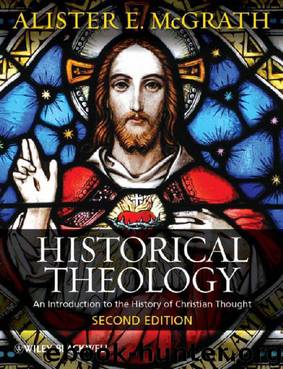Historical Theology by Alister E. McGrath

Author:Alister E. McGrath [McGrath, Alister E.]
Language: eng
Format: epub
Publisher: Wiley
Published: 2012-05-08T04:00:00+00:00
The role of tradition
The sola scriptura principle of the reformers would seem to eliminate any reference to tradition in the formation of Christian doctrine. In fact, however, the magisterial reformers had a very positive understanding of tradition, as we shall see, although the radical reformers did indeed adopt the more negative attitude toward tradition which the slogan might seem to imply. It will be helpful if we begin our discussion of this matter by exploring some understandings of the role of tradition found in the Middle Ages; readers might also like to look at case study 1.1, which examines the issues as they were set out during the patristic period.
For most medieval theologians, Scripture was the materially sufficient source of Christian doctrine. In other words, everything that was of essential importance to the Christian faith was contained in Scripture. There was no need to look anywhere else for material relevant to Christian theology. There were certainly matters on which Scripture had nothing to say – for example, who wrote the Apostles’ Creed, at what precise moment during the celebration of the eucharist the bread and wine became the body and blood of Christ, or whether the practice of baptism was intended solely for adult believers. On these matters, the church felt at liberty to attempt to work out what Scripture implied, although their judgments were regarded as subordinate to Scripture itself.
By the end of the Middle Ages, however, the concept of “tradition” had come to be of major importance in relation to the interpretation and authority of Scripture. Scholars such as Heiko A. Oberman (1930–2001) have shown that two quite different concepts of tradition were in circulation in the late Middle Ages, which may be designated as “Tradition 1” and “Tradition 2.” As we noted earlier (see case study 1.1), in response to various controversies within the early church, especially the threat from Gnosticism, a “traditional” method of understanding certain passages of Scripture began to develop. Second-century patristic theologians such as Irenaeus of Lyons began to develop the idea of an authorized way of interpreting certain texts of Scripture, which he argued went back to the time of the apostles themselves. Scripture couldn’t be interpreted in any random way: it had to be interpreted within the context of the historical continuity of the Christian church. The parameters of its interpretation were historically fixed and “given.” Oberman designates this understanding of tradition as “Tradition 1.” “Tradition” here means simply “a traditional way of interpreting Scripture within the community of faith.”
In the fourteenth and fifteenth centuries, however, a somewhat different understanding of tradition developed. “Tradition” was now understood to be a separate and distinct source of revelation in addition to Scripture. Scripture, it was argued, was silent on a number of points – but God had providentially arranged for a second source of revelation to supplement this deficiency: a stream of unwritten tradition, going back to the apostles themselves. This tradition was passed down from one generation to another within the church. Oberman designates this understanding of tradition as “Tradition 2.
Download
This site does not store any files on its server. We only index and link to content provided by other sites. Please contact the content providers to delete copyright contents if any and email us, we'll remove relevant links or contents immediately.
The Lost Art of Listening by Michael P. Nichols(6501)
Why I Am Not A Calvinist by Dr. Peter S. Ruckman(3779)
The Rosicrucians by Christopher McIntosh(3065)
Wicca: a guide for the solitary practitioner by Scott Cunningham(2714)
Signature in the Cell: DNA and the Evidence for Intelligent Design by Stephen C. Meyer(2512)
Real Sex by Lauren F. Winner(2494)
The Holy Spirit by Billy Graham(2437)
To Light a Sacred Flame by Silver RavenWolf(2365)
The End of Faith by Sam Harris(2304)
The Gnostic Gospels by Pagels Elaine(2045)
Nine Parts of Desire by Geraldine Brooks(2012)
Waking Up by Sam Harris(1969)
Heavens on Earth by Michael Shermer(1961)
Devil, The by Almond Philip C(1912)
Jesus by Paul Johnson(1899)
The God delusion by Richard Dawkins(1861)
Kundalini by Gopi Krishna(1830)
Chosen by God by R. C. Sproul(1775)
The Nature of Consciousness by Rupert Spira(1698)
